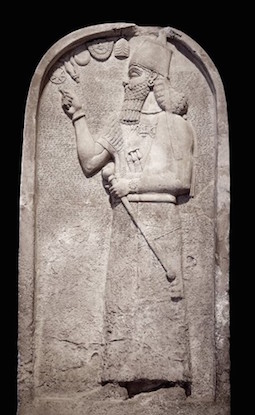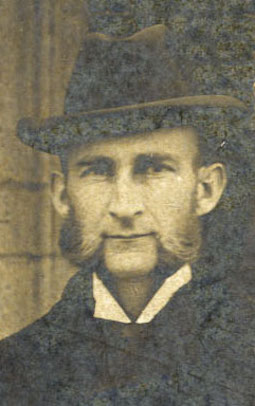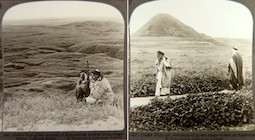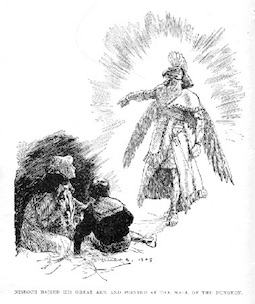Abandoned antiquity: views of Kalhu in 1900
If in 1850 ancient Kalhu was not yet clearly visible from the modern site of Nimrud, by 1900 Nimrud itself had lost all geographical reality in the English speaking world. There could be no view of Kalhu from Nimrud because there was no-one on site, and no-one of any academic authority had set foot there for decades. And for the new generation of university-based Assyriologists TT , the heroic story of Layard's PGP adventures still overshadowed attempts to understand the ancient city.
The view from the field
In 1900 Nimrud looked much as it had done fifty years before, except that more sculptures had been removed from the Northwest Palace (Image 1). For a few years after Layard's expedition to Nimrud had shut up shop, other adventurous entrepreneurs moved in to quarry for further bas-reliefs TT . The most eager clients were north American Protestant TT colleges, who wanted concrete confirmation of Biblical truth, in the face of increasing scientism in popular culture (1), (2). The figure of the winged genie TT was particularly resonant, because it had become identified with Nisroch PGP , the deity of the temple in which king Sennacherib PGP was supposedly murdered, according to the Old Testament Book of Kings (II Kings 19:36–37). However, we now understand both Nimrud and Nisroch to be later corruptions of the name of Ninurta PGP , the god of victory whose temple Layard had unearthed just to the north of the palace at Nimrud.
The Crimean War TT of the mid-1850s, and its decades-long aftermath, discouraged further European explorations. Nimrud had only sporadic visits from western travellers, in the 1860s and 70s, who made few further significant discoveries (3). And then for several decades the site was left to its fate.
The view from the museum

Image 2: This enormous carving of king Assurnasirpal II PGP , nearly 3m tall and weighing around 4 tonnes, was shipped from the ruins of Ninurta's temple to the British Museum. It is covered with a cuneiform inscription which enabled Rawlinson PGP and Layard to identify Nimrud as the ancient Assyrian city of Kalhu (biblical Calah). BM 118005 © British Museum View this image on the British Museum's website.
Although the site of Nimrud itself was now virtually inaccessible, in the British Museum TT , Layard's discoveries still dominated the ground floor of the building. The Museum's catalogue of 1900 not only gives detailed descriptions of the monuments themselves but also reproduces Layard's sketch plans of the Northwest Palace and the citadel of Nimrud (4). Kalhu had, to all intents and purposes, moved to London.
The inscriptional evidence gleaned from Nimrud had also become increasingly meaningful. Already by 1853, in Discoveries in the Ruins of Nineveh and Babylon, Layard presented summaries of the main monumental texts as deciphered by Rawlinson PGP and Hincks PGP . Of particular importance was a huge stela TT of "the early Nimroud king" which he had found at the entrance to the temple of "the god of war" (that is, the stele of Assurnasirpal II PGP from Ninurta's temple, now housed in the British Museum) (Image 2). It revealed that "the quarter of Nineveh now called Nimroud" had been known as Kalhu—Biblical Calah—in ancient times (5). Layard gave examples of the king's military campaigns and noted the existence of "an account ... of the building of the north-west palace of Nimroud, which, when deciphered, will be of considerable interest, and may enable us to restore that edifice."
The view from the university

Image 3: The Reverend Robert William Rogers PGP (1864-1930) was a typical turn-of-the century American Assyriologist, in that he was trained primarily in Old Testament history and theology, and taught in a seminary for training Methodist TT ministers. Image © Drew University. View image on Drew University's website.
Sadly, however, few of Layard's successors took him up on the offer, even though cuneiform TT rapidly became a meaningful script. From the 1870s onwards, Assyriology moved from the field into the university, and became increasingly recognised as a valid subject of academic study (6). In the years around 1900, several desk-bound academics wrote popular accounts of Assyrian (and Babylonian PGP ) history and culture ((7), (8), (9). But few had ever set foot in the Middle East or even, perhaps, in the British Museum. Unsurprisingly they struggled to conjure the reality of the ancient city.
One of the most popular turn-of-the-century accounts of Assyrian history, now long forgotten, was Reverend Robert William Rogers' PGP A history of Babylonia and Assyria (10). Rogers has now faded into obscurity but was eminent in his day, as Professor of Hebrew and Old Testament Exegesis TT at Drew Theological Seminary TT in New Jersey and a life-long Visiting Fellow of St John's College, Oxford (Image 3). His book, first published in 1900, ran to a sixth edition by 1915 and was widely considered to be a standard (11), (12). Rogers devotes over 20 pages to Layard's derring-do in discovering Nimrud but almost entirely ignores ancient Kalhu, dealing with it in a couple of paragraphs (13). Instead, he cherry-picks Assurnasirpal and Shalmaneser's PGP Annals for their military content — endless conquests, endless victories — and by and large ignores these kings' detailed descriptions of constructing of Kalhu itself. Paradoxically, the geography of the edges of empire comes to the fore, while the centre vanishes from view.
Other views
Elsewhere in Britain, Layard's stone kings and genies had lost the power to impress the imperial classes. They gradually found their way from the private stately homes of his former patrons to public institutions such as the Fitzwilliam Museum in Cambridge. Ideas of empire had changed. Britain's so-called 'white colonies' of Canada, Australia, and New Zealand had been granted significant autonomy, while the increasing dominance of France, Russia and Germany meant that Britain's monopoly on world power was not as clear cut as half a century before. Even though Layard—who had died only a few years before—had been elevated into the ranks of the great Victorian discoverers, Assyria was simply no longer fashionable amongst the ruling classes.
Devout Christianity was also on the wane, as Darwinism, geology and indeed archaeology became increasingly mainstream in British intellectual life (16). Paradoxically, the cuneiform inscriptions from Nimrud, and other Assyrian cities, played a large part in undermining belief in the literal veracity of the Christian scriptures. Some supposed Assyrian kings—Pul of the Book of Kings, for instance (II Kings 15:19)—were nowhere to be found in the Assyrian evidence itself (17). Conversely, it turned out large swathes of Assyrian history passed entirely unremarked in the Old Testament. But most damning, perhaps, were those events preserved in both Biblical and Assyrian sources. Most famously, king Sennacherib's siege of Jerusalem (e.g., II Kings 18-19) was now just the scene of an ambiguous military encounter rather than the cue for a divine miracle (18).
Even the formerly awe-inspiring winged genies of Nimrud had lost their power to impress and terrify. One of the most popular British children's authors of the day was E. Nesbit PGP . Her book The Railway Children, and the 1970 film which is based on it, are still widely enjoyed in Britain today. In The Story of the Amulet (1906) an ordinary middle-class family of children is accidentally transported to ancient Babylon PGP . The only way to get back is to summon "the strange and terrible figure" of a Nisroch, or winged genie (Image 4). He turns out to be a benign and helpful "dear" who happily helps the children return home (19). There are few more pointed symbols than this of the British domestication of the once deeply alien Nimrud.
18 Dec 2019References
- Holloway, S.W., 2004. "Nineveh sails for the New World: Assyria envisioned by nineteenth-century America," Iraq 66: 243-56 (PDF available via JSTOR for subscribers). (Find in text ^)
- Cohen, A. and S.E. Kangas (eds.), 2010. Assyrian Reliefs from the Palace of Ashurnasirpal: A Cultural Biography, Hanover, NH: Hood Museum of Art . (Find in text ^)
- Green, A.R., 2008. "Julius Weber (1838-1906) and the Swiss excavations at Nimrud in c.1860 together with records of other ninteenth-century antiquarian researches at the site", in J.E. Curtis, J. McCall, D. Collon and L. al-Gailani Werr (eds.), New Light on Nimrud: Proceedings of the Nimrud Conference, 11th-13th March 2002, London: British Institute for the Study of Iraq (free PDF from BISI, 22 MB), pp. 23–30. (Find in text ^)
- British Museum, 1900. A Guide to the Babylonian and Assyrian Antiquities. London: printed by order of the Trustees, pp. 13-14. (Find in text ^)
- Layard, A.H., 1853. Discoveries in the Ruins of Nineveh and Babylon, London: John Murray (free online edition via The Internet Archive), p. 294. (Find in text ^)
- Lyon, D.M., 1896. "A half century of Assyriology", The Biblical World 8: 124-142 (PDF available via JSTOR for subscribers). (Find in text ^)
- Jastrow, M., 1898. The Religion of Babylonia and Assyria, Boston: Ginn & Company. (Find in text ^)
- Krall, J., 1898. Grudriss der altorientalischen Geschichte, I: Bis auf Kyros, Vienna: Alfred Hölder. (Find in text ^)
- Sayce, A.H., 1900. Babylonians and Assyrians: Life and Custom, London: J.C. Nimmo. (Find in text ^)
- Rogers, Rev. R.W., 1900. A History of Assyria and Babylonia, 2 vols., New York: Eeaton & Mains (free online edition at The Internet Archive). (Find in text ^)
- Jastrow, M., 1901. Review of R.W. Rogers, A History of Assyria and Babylonia, The American Journal of Theology 5: 763–6 (PDF available via JSTOR for subscribers). (Find in text ^)
- Price, I.M., 1901. Review of R.W. Rogers, A History of Babylonia and Assyria, The Biblical World 17: 387–90 (PDF available via JSTOR for subscribers). (Find in text ^)
- Rogers, Rev. R.W., 1900. A History of Assyria and Babylonia, 2 vols., New York: Eeaton & Mains (free online edition at The Internet Archive), pp. I 138-160; II 13. (Find in text ^)
- Nesbit, E., 1906. The Story of the Amulet, London: T. Fisher Unwin, p. 168. (Find in text ^)
- Marchant, J., 2006. "'Exactly as it was'? H.R. Millar's expansons and subversions of the Psammead trilogy", in R.E. Jones (ed.), E. Nesbit's Psammead Trilogy: A Children's Classic at 100, Scarecrow Press, pp. 231-280. (Find in text ^)
- Lindberg, D.C. and R.L. Numbers (eds.), 2003. When Science and Christianity Meet, Chicago: University of Chicago Press, pp. 139-202. (Find in text ^)
- Holloway, S.W., 2003. "The quest for Sargon, Pul, and Tiglath-Pileser in the 19th century," in M.W. Chavalas and K. Lawson Younger, Jr. (eds.), Mesopotamia and the Bible: Comparative Explorations (Journal for the Study of the Old Testament, Supplement Series, 341). Sheffield: Sheffield Academic Press/ Grand Rapids: Baker Academic, pp. 68-87.. (Find in text ^)
- Kalimi, I. and S.F.C. Richardson (eds.), 2014. Sennacherib at the Gates of Jerusalem: Story, History and Historiography, Leiden: Brill. (Find in text ^)
- Briggs, J., 2006. "The Amulet and other stories of time", in R.E. Jones (ed.), E. Nesbit's Psammead Trilogy: A Children's Classic at 100, Scarecrow Press, pp. 215-230. (Find in text ^)
Further reading
- Holloway, S.W. (ed.), 2007. Orientalism, Assyriology and the Bible (Hebrew Bible Monographs, 10), Sheffield: Sheffield Phoenix Press.
- Reade, J.E., 2008, "Nineteenth-century Nimrud: motivation, orientation, conservation", in J.E. Curtis, J. McCall, D. Collon and L. al-Gailani Werr (eds.), New Light on Nimrud: Proceedings of the Nimrud Conference, 11th-13th March 2002, London: British Institute for the Study of Iraq (free PDF from BISI, 22 MB), pp. 1–22.
Eleanor Robson
Eleanor Robson, 'Abandoned antiquity: views of Kalhu in 1900', Nimrud: Materialities of Assyrian Knowledge Production, The Nimrud Project at Oracc.org, 2019 [http://oracc.museum.upenn.edu/nimrud/modernnimrud/onthemound/1900/]

